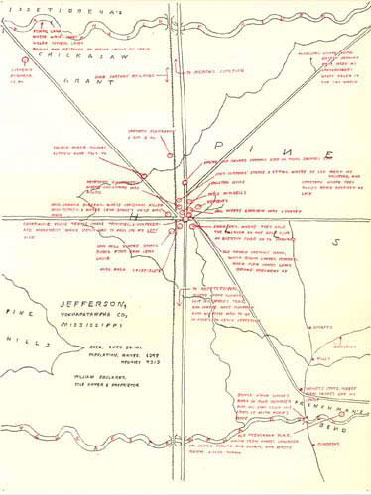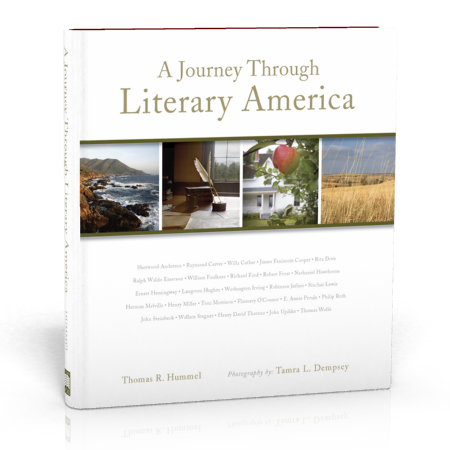Using the map, which the cartographer (William Faulkner) briefly annotated, it is possible to get a good tour of some of the landmarks.

[optinlocker]
Sutpen’s Hundred (Absalom, Absalom!)– Thomas Sutpen came to the little town of Jefferson from the West Indies in 1833 with a French architect, a number of slaves who did not speak English and a relentless ambition to carve a hundred square mile plantation out of the wilderness. He starts a raree show, pitting his blacks against one another, and sometimes against himself. Told from the perspective of Quentin Compson’s imaginings:
Immobile, bearded and hand palm-lifted the horseman sat; behind him the wild blacks and the captive architect huddled quietly, carrying in bloodless paradox the shovels and picks and axes of peaceful conquest. Then in the long unamaze Quentin seemed to watch them overrun suddenly the hundred square miles of tranquil and astonished earth and drag house and formal gardens out of the soundless Nothing and clap them down like cards on a table beneath the up-palm immobile and pontific, creating the Sutpen’s Hundred, the Be Sutpen’s Hundred like the oldentime Be Light.
Sartoris Plantation – down the road a piece from John Sartoris’ statue and effigy, where he can watch his railroad (Sartoris). The Sartoris family, which bore many resemblances to Faulkner’s own, including the railroad, was one of the most prominent in Yoknapatawpha County.
Frenchman’s Bend – from the Snopes Triligy (The Hamlet [1940], The Town [1957], The Mansion [1959])
A section of rich river-bottom country lying twenty miles southeast of Jefferson. Hill-cradled and remote, definite yet without boundaries, straddling into two counties and owing allegiance to neither, it had been the original grant and site of a tremendous pre-Civil War plantation, the ruins of which—the gutted shell of an enormous house with its fallen stables and slave quarters and overgrown gardens and brick terraces and promenades—were still known as the Old Frenchman’s place. — The Hamlet
Frenchman Place – after which Frenchman’s Bend was named, is the piece of tumbling down property “which Flem Snopes unloaded on Henry Armistid and Suratt” and Ratliff in The Hamlet and “where Popeye killed Tommy” (Sanctuary).
Varner’s Store, “where Flem Snopes got his start” (The Hamlet). Every time Ratliff, the clever sewing machine salesman in the Snopes trilogy, turns around, another Snopes relative has moved into Frenchman’s Bend. Jody Varner gave Flem Snopes a job at his store as insurance, so that Ab Varner wouldn’t burn down one of his barns.
Confederate Monument – “Which Benjy Had to Pass on His Left Side” (The Sound and the Fury). Downtown, next to the Jefferson courthouse. This monument exists in Yoknapatawpha County, and in Lafayette County in the real world.
Compson’s, “where they sold the pasture to the golf club so Quentin could go to Harvard” (The Sound and the Fury). The sacrifice turned out to be a waste, as Quentin committed suicide. The family also included Benjy, who was mentally retarded. Faulkner is believed to have been inspired by the family of a local doctor, the ______, who had a retarded son.
Safe in Jefferson where life lived too with its incomprehensible passion and turmoil and grief and fury and despair but here at six o’clock you could close the covers on it and even the weightless hand of a child could put it back among its unfeatured kindred on the quiet eternal shelves and turn the key on it for the whole dreamless night.
[/optinlocker]

